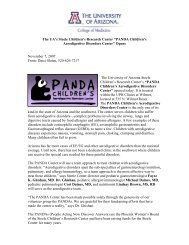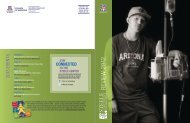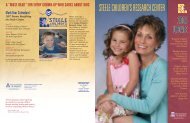Read More - the Steele Children's Research Center - University of ...
Read More - the Steele Children's Research Center - University of ...
Read More - the Steele Children's Research Center - University of ...
You also want an ePaper? Increase the reach of your titles
YUMPU automatically turns print PDFs into web optimized ePapers that Google loves.
NHE-3 Providing Clues to Deadly Diarrhea<br />
The numbers are staggering and heartbreaking: approximately<br />
5 million children under <strong>the</strong> age <strong>of</strong> 5 die from diarrhea every<br />
year. One <strong>of</strong> <strong>the</strong> most widespread and pervasive health problems<br />
in underdeveloped nations, diarrhea is a leading cause <strong>of</strong><br />
childhood deaths worldwide.<br />
With a $1.8 million grant from <strong>the</strong> National Institutes <strong>of</strong><br />
Health (NIH), <strong>Steele</strong> <strong>Center</strong> researchers Fayez K. Ghishan, MD,<br />
Pr<strong>of</strong>essor and Head, and Pawel Kiela, PhD, <strong>Research</strong> Associate<br />
Pr<strong>of</strong>essor, are investigating <strong>the</strong> reasons why diarrhea can be<br />
so deadly. “What we have discovered in <strong>the</strong> lab is <strong>of</strong> enormous<br />
significance and answers <strong>the</strong> question <strong>of</strong> why so many children<br />
die from diarrhea,” Dr. Ghishan says.<br />
Most children (and adults) are plagued by acute diarrhea<br />
a few times each year. We’re all familiar with <strong>the</strong> unwelcome<br />
symptoms: abdominal pain and cramping, bloating, nausea,<br />
and loose bowel movements. Individuals with gastrointestinal<br />
disorders like celiac disease, ulcerative colitis and Crohn’s<br />
disease frequently struggle with inflammatory-associated chronic<br />
diarrhea.<br />
Diarrhea occurs because <strong>the</strong> intestines cannot absorb salt.<br />
Caused by bacteria, viruses, parasites, medications, functional<br />
bowel disorders and food allergies, diarrhea typically is treated<br />
by drinking<br />
ample amounts <strong>of</strong><br />
electrolyte-rich<br />
liquids to provide<br />
essential salts<br />
and nutrients.<br />
Normally, diarrhea<br />
is resolved within<br />
a few days,<br />
although some<br />
conditions that<br />
cause chronic<br />
diarrhea require<br />
medical treatment.<br />
For children<br />
living in sanitary<br />
conditions with<br />
clean water and<br />
The epi<strong>the</strong>lial lining when NHE-3 is not<br />
inhibited.<br />
plenty <strong>of</strong> food, diarrhea is easily treated. However, because so<br />
much <strong>of</strong> <strong>the</strong> water in <strong>the</strong> Third World is contaminated, most<br />
<strong>of</strong> <strong>the</strong> population is exposed to disease-carrying bacteria.<br />
Malnutrition leaves children weakened, making <strong>the</strong>m especially<br />
susceptible to infection from tainted water or o<strong>the</strong>r means. And<br />
<strong>the</strong> immune systems <strong>of</strong> very young children are not completely<br />
Drs. Kiela and Ghishan<br />
developed, so when <strong>the</strong>y get diarrhea, it quickly can develop into<br />
a dangerous condition.<br />
“Severe diarrhea can lead to death in a matter <strong>of</strong> days—from<br />
dehydration or sepsis resulting from highly inflamed intestines,”<br />
Dr. Kiela says.<br />
Discovery through research<br />
Drs. Ghishan and Pawel are working at <strong>the</strong> basic-science<br />
level to understand what happens in <strong>the</strong> GI tract during severe<br />
diarrhea.<br />
Individuals have nine sodium-hydrogen exchangers, or<br />
“transporters,” known as NHE (Na-H-Exchanger). NHEs are<br />
proteins responsible for transporting sodium across <strong>the</strong> GI tract<br />
for absorption. “The classic premise to explain diarrhea is that<br />
inflammation inhibits <strong>the</strong> sodium-hydrogen transporters’ ability<br />
to move salt through <strong>the</strong> GI tract. Thus, your intestines cannot<br />
absorb salt and this is why you get diarrhea,” explains Dr.<br />
Ghishan.<br />
Drs. Ghishan and Kiela have documented new findings about<br />
<strong>the</strong> role <strong>of</strong> NHE-3, one <strong>of</strong> <strong>the</strong> nine sodium-hydrogen transporters.<br />
It is well known that NHE-3 is <strong>the</strong> predominant sodium-hydrogen<br />
transporter responsible for <strong>the</strong> majority <strong>of</strong> sodium transport<br />
across <strong>the</strong> GI tract. “When <strong>the</strong> intestines become inflamed,<br />
NHE-3 becomes inhibited, so it can’t move sodium through <strong>the</strong><br />
GI tract, resulting in diarrhea,” says Dr. Kiela.<br />
“But <strong>the</strong>re is more,” Dr. Ghishan explains. “Our research has<br />
revealed that NHE-3 has a role beyond that <strong>of</strong> transporting salt<br />
to <strong>the</strong> GI tract for absorption. We found that NHE-3 is involved<br />
in <strong>the</strong> integrity <strong>of</strong> <strong>the</strong> epi<strong>the</strong>lial lining—<strong>the</strong> cellular structure<br />
that creates <strong>the</strong> intestinal wall, which separates<br />
<strong>the</strong> gut from <strong>the</strong> bloodstream. We discovered that<br />
when NHE-3 is inhibited, or ‘knocked down’ by<br />
inflammation, <strong>the</strong> intestinal wall is breached—<strong>the</strong><br />
gut becomes leaky—and bacteria escape from <strong>the</strong><br />
intestines into <strong>the</strong> bloodstream. Consequently, sepsis<br />
likely develops, which may cause death,” he explains.<br />
“This is why so many children die.”<br />
“The inhibition <strong>of</strong> NHE-3 loosens <strong>the</strong> tightly<br />
woven fabric <strong>of</strong> <strong>the</strong> intestines. This is <strong>the</strong> mechanism<br />
<strong>of</strong> action for why <strong>the</strong> gut becomes leaky. Now, <strong>the</strong><br />
task before us is to identify compounds that will<br />
restore NHE-3, so that <strong>the</strong> epi<strong>the</strong>lial layer can be<br />
restored, reducing <strong>the</strong> deadly effects <strong>of</strong> diarrhea,”<br />
says Dr. Ghishan.<br />
The epi<strong>the</strong>lial lining when NHE-3 is<br />
inhibited. The red area is bacteria leaking<br />
through it.<br />
“Our research not only sheds new light on<br />
<strong>the</strong> function <strong>of</strong> this important sodium-hydrogen<br />
transporter, but also suggests that NHE-3 should<br />
be considered in future <strong>the</strong>rapeutic approaches to<br />
diarrhea and disorders that cause chronic diarrhea,”<br />
Dr. Kiela says.<br />
Dr. Robert Berg Receives<br />
American Heart Association<br />
“Lifetime Achievement Award”<br />
<strong>Steele</strong> <strong>Center</strong> pediatric intensivist and<br />
researcher Robert Berg, MD, Pr<strong>of</strong>essor<br />
<strong>of</strong> Pediatrics and Associate Dean for<br />
Clinical Affairs, UA College <strong>of</strong> Medicine,<br />
was honored by <strong>the</strong> American Heart<br />
Association. Dr. Berg was chosen out<br />
from approximately 350 nominees from<br />
around <strong>the</strong> world for <strong>the</strong> prestigious<br />
“2006 Resuscitation Science Symposium<br />
Lifetime Achievement Award for a Cardiac<br />
Resuscitation Scientist.”<br />
This award is presented annually to<br />
recognize an individual for outstanding contributions to <strong>the</strong> cardiac<br />
resuscitation science field. Dr. Berg is <strong>the</strong> fourth recipient <strong>of</strong> this<br />
award for an international leader in cardiac arrest and CPR research.<br />
“Dr. Berg is a world-class researcher and physician, and this award<br />
acknowledges his contributions to improving cardiac resuscitation in<br />
both children and adults,” says Dr. Ghishan.<br />
Dr. Berg’s research focuses on pediatric and adult cardiac arrest,<br />
CPR, ventricular fibrillation and defibrillation, catecholamine<br />
pharmacology, and hemodynamics. Dr. Berg has published more than<br />
150 research articles, books, and abstracts, and is acknowledged<br />
nationally and internationally as a leader in improving CPR methods.<br />
He has contributed to <strong>the</strong> development <strong>of</strong> “Continuous Chest<br />
Compression CPR” or “Cardio-cerebral Resuscitation,” a simple and<br />
exciting technique that has increased survival from sudden-collapse<br />
cardiac arrest.<br />
Dr. Berg was <strong>the</strong> senior author on two landmark studies<br />
recently published in The New England Journal <strong>of</strong> Medicine. The<br />
first <strong>of</strong> <strong>the</strong>se articles, “A comparison <strong>of</strong> high-dose and standarddose<br />
epinephrine in children with cardiac arrest,” established <strong>the</strong><br />
appropriate dose <strong>of</strong> epinephrine for children in cardiac arrest.<br />
The o<strong>the</strong>r article, “Outcomes <strong>of</strong> Pediatric In-Hospital Ventricular<br />
Fibrillation,” established that ventricular fibrillation occurs in more<br />
than 25 percent <strong>of</strong> in-hospital pediatric cardiac arrests (much more<br />
commonly than previously thought), and revealed a new paradigm<br />
for understanding and treating in-hospital pediatric ventricular<br />
fibrillation cardiac arrest.<br />
“This is a great honor,” says Dr. Berg. “I’m proud to be in<br />
a community <strong>of</strong> health-care pr<strong>of</strong>essionals that is committed to<br />
improving <strong>the</strong> outcomes <strong>of</strong> individuals who have suffered from<br />
cardiac arrest.”<br />
14 15







